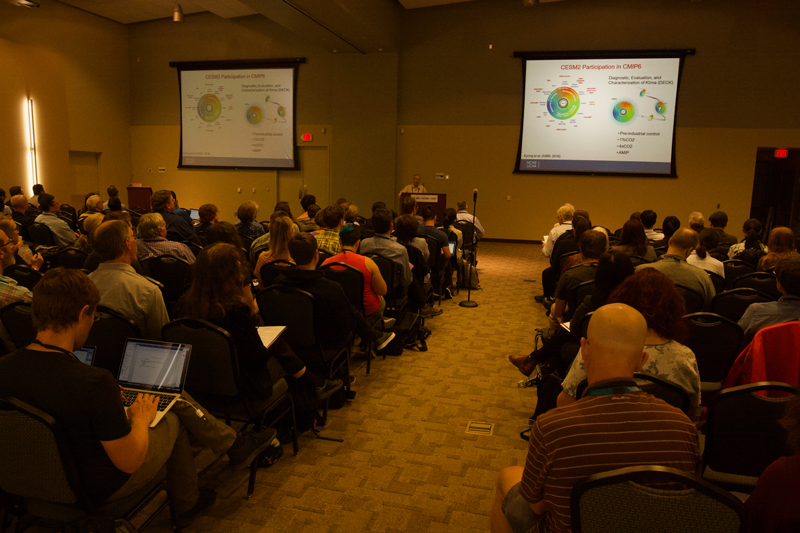Andrew Gettelman knew that something was missing, and he thought that he could find it when, in January 2018, he took off in a plane from Hobart, Australia, and flew into low-lying clouds hovering over the Southern Ocean.
Gettelman is a cloud physicist and senior scientist who works at the National Center for Atmospheric Research (NCAR) in Boulder, Colo., and he is part of the legions of researchers who help design and build one of the world’s leading computer models that simulates the planet’s climate: the Community Earth System Model (CESM).
Last year, the latest version of CESM, CESM2, debuted. Results from this new version’s simulations point toward a much hotter future climate—driven by humans continuing to burn fossil fuels and pump greenhouse gases into the atmosphere—than any previous version of CESM.
The jump comes after simulations in which researchers doubled the concentration of carbon dioxide in the atmosphere, starting with levels that existed before the dawn of the Industrial Revolution. (Those concentrations were about 280 parts per million. Today, levels are about 415 parts per million.)
Results from the previous version of the simulation run in 2006 showed 2.9°C of warming; the version of the model run in 2009 projected 3.2°C of warming; the 2012 version projected 4.1°C of warming.
The version run this year projected warming of 5.3°C when the carbon dioxide in the atmosphere doubles from pre-Industrial levels. The planet has already warmed by 0.7°C to 0.9°C.

“We are not alone,” said NCAR ocean and climate modeler Gokhan Danabasoglu during a presentation about the results last week in Boulder at NCAR’s annual CESM workshop.
Other climate models constructed by other research groups, Danabasoglu explained, are finding similarly high temperature values. They include the Energy Exascale Earth System Model (E3SM), built by the U.S. Department of Energy, which reported a value of 5.3°C, and the Canadian Earth System Model (CanESM), which reports a value of 5.7°C.
Supercooled Liquid Clouds
One of the reasons for the jump likely has to do with how clouds behave in CESM2. That is why Gettelman was on a plane darting over the Southern Ocean. “It’s pretty interesting flying at a high Mach number 300 feet [91 meters] over the Southern Ocean when you’ve been briefed on where the survival suits are and there’s nothing out there for a thousand miles [1,600 kilometers] in any direction,” he said.
“Even if we take mitigation steps and we’re not on a high-emissions trajectory, it still means we’ll get more warming.”
Gettelman did not fly through a cloud made mostly of vapor or of ice. It was a supercooled liquid cloud, one in which vapor condenses into water droplets that although they exist at subzero temperatures, do not freeze. Clouds like this are brighter than other clouds, and they reflect sunlight back out into space, helping to keep the planet cool. But as the planet warms, these clouds seem to be getting thinner, Gettelman explained, which erodes their cooling effect.
Gettelman and his colleagues added the missing knowledge about supercooled liquid clouds to CESM2, along with other changes to the models’ cloud physics, in an effort to make the clouds in the model behave more like clouds do in the real world.
Results from models like CESM2 are what the United Nation’s Intergovernmental Panel on Climate Change references in its reports on the state of climate change. It publishes data on just how bad climate change will get—including forecasts on how events like wildfires, hurricanes, and droughts will become more commonplace—depending on the extent to which humans manage to cut their fuel emissions.
“Even if we take mitigation steps and we’re not on a high-emissions trajectory, it still means we’ll get more warming,” Gettelman said.
“It potentially means larger climate impacts if this is correct.”
It’s too early, though, to say whether or not the 5.3°C jump is set in stone, according to Ben Sanderson, a climate scientist at the European Center for Advanced Research and Training for Computational Science in Toulouse, France, and an affiliate scientist with NCAR who is not directly involved in CESM’s development. “It’s fundamentally hard to constrain because there’s no direct way to observe it,” he said.
As this is a brand-new result, Sanderson added, there may be other model forces behind it that researchers may yet unearth.
Regardless, it does not bode well that other modeling groups are getting similar results.
“The fact that other people with independent modeling decisions and independent modeling pathways totally from us ended up at the same place as they got their models more realistic, that’s what bothers us,” Gettelman said. “It potentially means larger climate impacts if this is correct.”
—Lucas Joel, Freelance Journalist
5 July 2019: This article was updated to clarify the warming projected when previous versions of the simulations were run.
Citation:
Joel, L. (2019), Latest climate model points to hotter Earth, Eos, 100, https://doi.org/10.1029/2019EO127245. Published on 28 June 2019.
Text © 2019. The authors. CC BY-NC-ND 3.0
Except where otherwise noted, images are subject to copyright. Any reuse without express permission from the copyright owner is prohibited.

